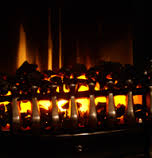A fire – whether a wildfire in natural, or an accident, or malicious arson – is a risk like any other, and can be risk-assessed, the same as a chemical spill, gas peak, flood or power failure. What’s the impact; how likely is it to happen; what would be the impact; and what could or should you do, to mitigate – not necessarily rule out altogether – that impact.
What are the connections between fire safety (also called life safety), and security, management? It may appear that fire safety is more in the minds of non-specialists, if only because an office or other building may have regular fire alarm tests, whether of the alarm sounding or an evacuation. Again, a fire event will affect security officers on site, as witnessed recently by Professional Security at Canary Wharf. In one of the office blocks, the fire alarm went off in mid-afternoon. After a typical delay while occupants ummed and ahhed about whether it was the fire alarm going off, and if so whether it was a genuine alarm that should be acted on, others came to confirm that an evacuation was in progress.
That’s really all there is to report; people obeyed instructions and avoided use of the lifts and filed calmly down the fire exit, onto the street. Canary Wharf uniformed security officers were on the scene, asking people to cross the road to be at a distance from the evacuated building.
Eric N Smith in the 2014 textbook, published by Elsevier, Workplace Security Essentials, makes a good point about a policy, whether a new one or reminding everyone of an existing one; be sure to communicate the “why.” For example, why do we have to practice evacuations twice a year? Due, you might say, to a local fire code; if not kept to, a site could be fined for noncompliance. “That would mean smaller raises or tighter department budgets.”
In other words, the humble fire drill is explained in terms that each non-fire or security employee can understand. Generally speaking, people get why there’s a fire drill, even though they may mill around in a car park while fire marshals and managers do the work of accounting for everyone, and sending everyone back indoors – hopefully not too cold or rained upon. How many buildings do the same drill for a terror-related or bomb threat evacuation, according to the UK official advice of ‘Run-Hide-Tell‘? Yet the likelihood of a serious fire, no more than a terror incident, is slight. Non-specialists may take for granted access control and video surveillance and feel no need to know a thing about them; the same goes for the red fire extinguishers they pass routinely. Evidently people feel more familiar, do not need to be told about, fire safety.
Fire safety is a security issue. As Matthew Millsaps put it in another Elsevier publication, the fourth (2015) edition of Security Supervision and Management, a fire ‘can quickly become the most taxing and resource-intensive calls for service that security teams will face’.
For fire requires response in an emergency – whether that fire extinguisher is put to use to tackle a fire, or in a terrorist incident a fire extinguisher may be an improvised weapon, as Smith suggested, against a gunman: “Look around your room right now and think about what could be a weapon.” As that implies, risk management is about imagining, acting on experience and site history, what might happen in the foreseeable future. Hence a drill, or table-top or other exercise; a life-threatening situation would be serious enough if it happened to make a practice necessary, but happens so rarely that employees do not have the knowledge of that situation to draw on.
How much about fire does the security manager need to know? It depends on the building – a 20-floor block has different risks than a two-storey one, a hotel or office has different risks than a warehouse. As Millsaps put it, ‘as each type of fire is classified, so is each type of construction’.
Hence the need for standards; and NSI can assess and verify competency of contractors who install and maintain kitchen fire protection systems to BAFE Scheme SP206; and can likewise cover fire extinguisher service and maintenance; and emergency lighting; besides fire detection systems, under scheme SP203.










